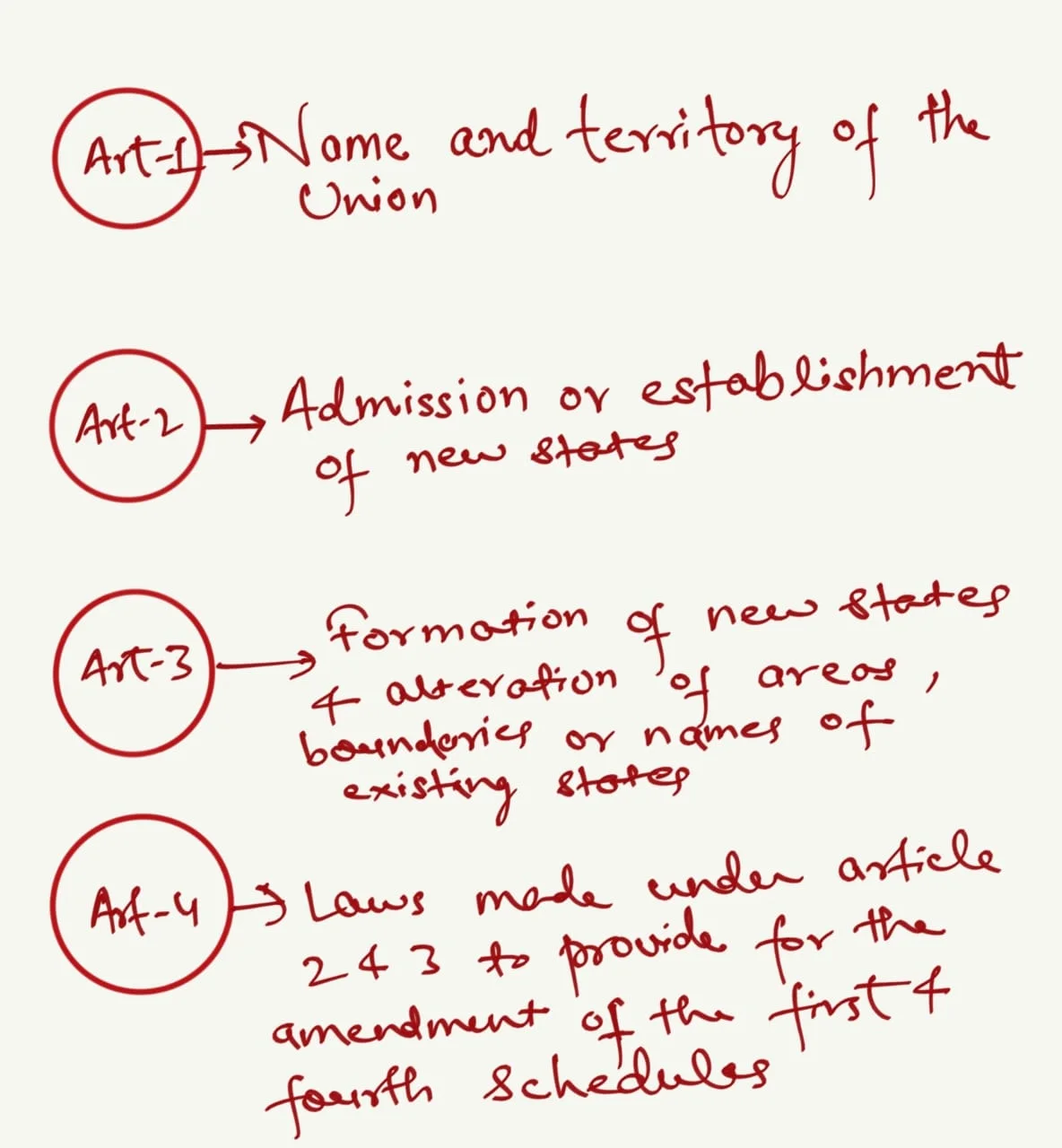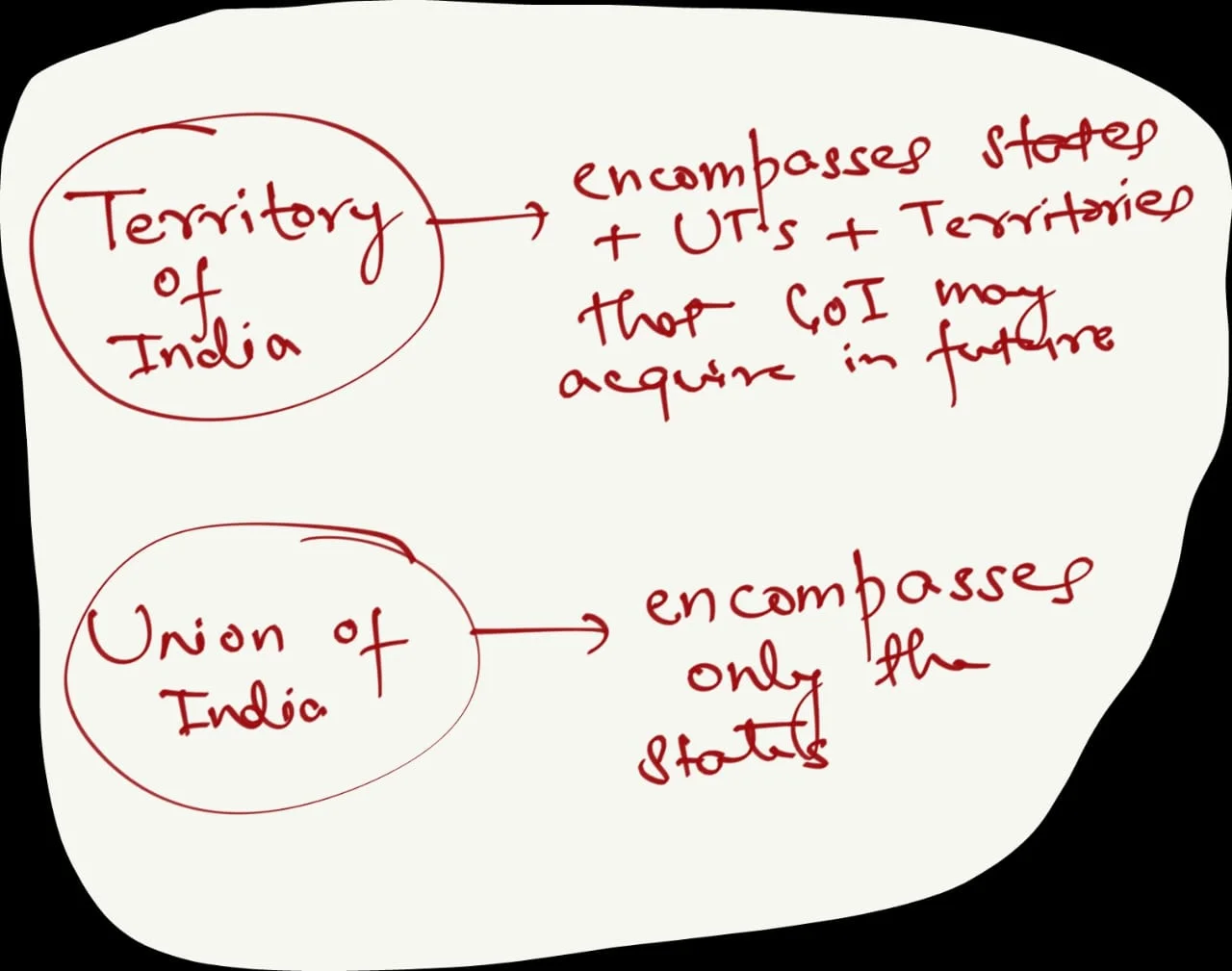India is described as a “Union of States” in its Constitution, encompassing 28 states and 8 union territories. Unlike many federations, Indian states do not possess individual sovereignty, citizenship, or constitutions. Articles 1 to 4 in Part-1 of the Constitution define the Union and its territory, detailing the country’s name, political structure, and the process for admitting and establishing new states.
Union and Its Territories: Understanding the Framework of Indian Federalism
Articles 1 to 4 under Part-1 of the constitution deals with the Union and its Territory.

Enroll now for UPSC Online Course
Article 1: A Union of States

-
- Definition of India: Article 1 of the Indian Constitution defines India, also known as Bharat, as a ‘Union of States‘.
- This article addresses two fundamental aspects:
- The name of the country
- The nature of its political structure.
- This article addresses two fundamental aspects:
- Name of the Country in the Constituent Assembly: In the Constituent Assembly, the choice of the country’s name was a matter of debate.
- Some members advocated for the traditional name, Bharat, while others favored the modern name, India.
- Consequently, a compromise was reached, and the Constitution acknowledges both names as ‘India, that is, Bharat.’
- Definition of India: Article 1 of the Indian Constitution defines India, also known as Bharat, as a ‘Union of States‘.
- Categorization of the Territory of India: Article 1 further categorizes the territory of India into three parts:

- Details of State and Union Territory Names and Boundaries: The names and territorial extent of states and union territories are detailed in the first schedule of the Constitution.
- Uniform Application: The provisions of the Constitution that pertain to the states are applicable uniformly to all states.
- Distinction Between ‘Territory of India’ and ‘Union of India’: Significantly, the term ‘Territory of India’ holds a broader scope compared to the ‘Union of India.’
- Role of States in the Federal System: States are integral members of the federal system and share powers with the central government.
- In contrast, union territories and acquired territories are under the direct administration of the Central government.
| Special Provisions outlined in Part XXI including Maharashtra, Gujarat, Nagaland, Assam, Manipur, Andhra Pradesh, Telangana, Sikkim, Mizoram, Arunachal Pradesh, Goa, and Karnataka.
These unique provisions cater to the distinctive needs of these states.Furthermore, it is important to note that the Fifth and Sixth Schedules contain distinct provisions governing the administration of scheduled areas and tribal areas within the states |
- Acquisition of Foreign Territories: As a sovereign state, India has acquired various foreign territories such as Dadra and Nagar Haveli, Goa, Daman and Diu, Puducherry, and Sikkim since the commencement of the Constitution.

Territorial Waters
- Definition of Territorial Waters: The limit of the territorial waters is now defined as the line, every point of which is twelve nautical miles away from the closest point of the applicable base line, as per Section 3(2) of the Territorial Waters, Continental Shelf, Exclusive Economic Zone and other Maritime Zones Act, 1976.
- Expansion of the Exclusive Economic Zone: The “exclusive economic zone” of India has been expanded by the government by another announcement dated January 15, 1977, to a maximum of 200 nautical miles beyond the coastal baseline.
- Legislative Framework for Expansion: This has been carried out in accordance with the 1976 Constitution (40th Amendment) Act and the Territorial Waters, Continental Shelf, Exclusive Economic Zone and Other Maritime Zones Act.
Article 2: Admission or Establishment of New States
- Article 2 grants authority to the Parliament to ‘admit into the Union of India or establish new states under terms and conditions it deems appropriate.’
- Therefore, Article 2 confers two distinct powers to the Parliament:
- Power to Admit New States: The power to admit new states into the Union of India, which pertains to states already in existence
- Power to Establish New States: The power to establish entirely new states that did not exist before.
Article 3: Formation of New States and Alteration of Areas, Boundaries or Names of Existing States
- Conditions for Implementation of Article 3: Nevertheless, Article 3 imposes two essential conditions to be fulfilled for its implementation:
- President’s Recommendation: A bill proposing the aforementioned changes can only be introduced in Parliament with the prior recommendation of the President.
- Consultation with State Legislature: Before offering this recommendation, the President must refer the bill to the concerned state legislature, seeking their views within a specified timeframe.
- Parliament’s Authority to Establish New States: Furthermore, Parliament’s authority to establish new states also extends to the creation of a new state or union territory by amalgamating a portion of any state or union territory with another state or union territory.
Comparison of Article 2 and 3
| Article 2 | Article 3 |
| Pertains to the admission or creation of new states that are not currently part of the Union of India. | Deals with the formation of new states or alterations to the existing states within the Union of India |
Article 4 of the Indian Constitution
- Exemption from Constitutional Amendment Procedures: Article 4 stipulates that laws enacted for the admission or establishment of new states (under Article 2) and the formation of new states, as well as changes in the areas, boundaries, or names of existing states (under Article 3), are not considered as amendments to the Constitution under Article 368.
- Ordinary Legislative Process: As a result, these laws can be passed by a simple majority through the ordinary legislative process.
Exchange of Territories
- Authority to Alter State Boundaries under Article 3: Regarding the power of Parliament to reduce the areas of a state (under Article 3), a question arose as to whether it also encompasses the authority to cede Indian territory to a foreign country.
- The Berubari Union Case (1960): This matter was examined by the Supreme Court in 1960 following a reference made by the President.
- The issue stemmed from the Central Government’s decision to cede a portion of territory known as Berubari Union in West Bengal to Pakistan, which triggered political agitation and controversy.
Exchange of Territories with Bangladesh
- Radcliffe Commission: At the time of India’s independence, Sir Cyril Radcliffe Commission demarcated the boundary between India and Pakistan as well as India and East Pakistan (now Bangladesh).
- Challenges of Enclaves: While dividing the territory in East Pakistan, Radcliffe did not pay attention to small patches of land called ‘enclaves’.
- These enclaves were, in the pre-independence era, called Chitmahals and they were used by the Raja of Cooch Behar and Maharaja of Rangpur as stakes in the game of chess.
- Resolution of Enclave Issues: Later several agreements such as the Nehru-Noon Agreement of 1958 tried to resolve the issue of enclaves.
- Finally, after Bangladesh’s independence from Pakistan in 1971, India and Bangladesh signed the 1974 Land Boundary Agreement (“1974 LBA“), to resolve outstanding issues.
- 100th Constitutional Amendment Act: This agreement was formally ratified by India in 2015 by passing the 100th Constitutional Amendment Act of 2015.
Enroll now for UPSC Online Course
-
- Under this agreement, India relinquished control over 111 enclaves to Bangladesh, while Bangladesh reciprocated by ceding 51 enclaves to India.
| Must Read | |
| Current Affairs | Editorial Analysis |
| Upsc Notes | Upsc Blogs |
| NCERT Notes | Free Main Answer Writing |
Conclusion
The Indian Constitution’s provisions on the Union and its territories ensure a cohesive yet flexible federal structure.
- By clearly defining the powers to admit, establish, and alter states, the Constitution maintains India’s unity and allows for adaptability.
- Historical agreements and amendments, such as the Land Boundary Agreement with Bangladesh, showcase India’s commitment to resolving territorial issues amicably and upholding its constitutional integrity.
Sign up for the PWOnlyIAS Online Course by Physics Wallah and start your journey to IAS success today!
| Related Articles | |
| CITIZENSHIP | Supreme Court of India: Jurisdiction, Powers, & Constitutional Role |
| STATES AND UNION TERRITORIES | Constitution: A Living Document |

 GS Foundation
GS Foundation Optional Course
Optional Course Combo Courses
Combo Courses Degree Program
Degree Program









